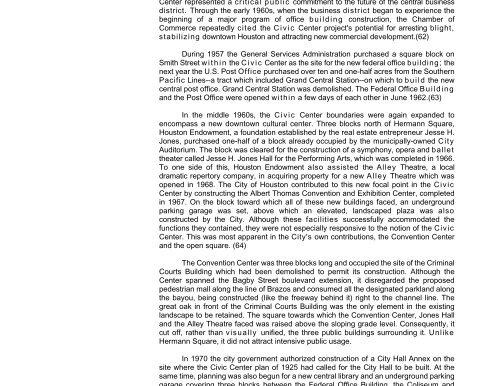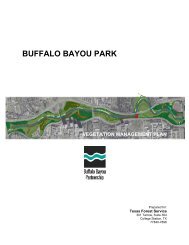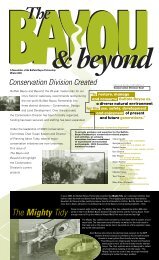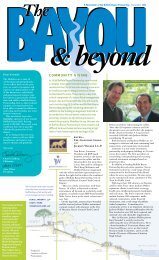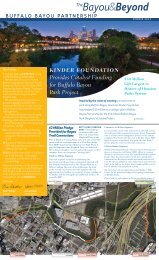Center represented a critical public commitment <strong>to</strong> <strong>the</strong> future <strong>of</strong> <strong>the</strong> central businessdistrict. Through <strong>the</strong> early 1960s, when <strong>the</strong> business district began <strong>to</strong> experience <strong>the</strong>beginning <strong>of</strong> a major program <strong>of</strong> <strong>of</strong>fice b u i l d i n g construction, <strong>the</strong> Chamber <strong>of</strong>Commerce repeatedly cited <strong>the</strong> C i v i c Center <strong>project</strong>'s potential for arresting blight,stabilizing down<strong>to</strong>wn Hous<strong>to</strong>n and attracting new commercial development.(62)During 1957 <strong>the</strong> General Services Administration purchased a square block onSmith Street w i t h i n <strong>the</strong> C i v i c Center as <strong>the</strong> site for <strong>the</strong> new federal <strong>of</strong>fice building; <strong>the</strong>next year <strong>the</strong> U.S. Post Office purchased over ten and one-half acres from <strong>the</strong> Sou<strong>the</strong>rnPacific Lines--a tract which included Grand Central Station--on which <strong>to</strong> b u i l d <strong>the</strong> newcentral post <strong>of</strong>fice. Grand Central Station was demolished. The Federal Office B u i l d i n gand <strong>the</strong> Post Office were opened within a few days <strong>of</strong> each o<strong>the</strong>r in June 1962.(63)In <strong>the</strong> middle 1960s, <strong>the</strong> C i v i c Center boundaries were again expanded <strong>to</strong>encompass a new down<strong>to</strong>wn cultural center. Three blocks north <strong>of</strong> Hermann Square,Hous<strong>to</strong>n Endowment, a foundation established by <strong>the</strong> real estate entrepreneur Jesse H.Jones, purchased one-half <strong>of</strong> a block already occupied by <strong>the</strong> municipally-owned CityAudi<strong>to</strong>rium. The block was cleared for <strong>the</strong> construction <strong>of</strong> a symphony, opera and ballet<strong>the</strong>ater called Jesse H. Jones Hall for <strong>the</strong> Performing Arts, which was completed in 1966.To one side <strong>of</strong> this, Hous<strong>to</strong>n Endowment also assisted <strong>the</strong> Alley Theatre, a localdramatic reper<strong>to</strong>ry company, in acquiring property for a new Alley Theatre which wasopened in 1968. The City <strong>of</strong> Hous<strong>to</strong>n contributed <strong>to</strong> this new focal point in <strong>the</strong> CivicCenter by constructing <strong>the</strong> Albert Thomas Convention and Exhibition Center, completedin 1967. On <strong>the</strong> block <strong>to</strong>ward which all <strong>of</strong> <strong>the</strong>se new buildings faced, an undergroundparking garage was set, above which an elevated, landscaped plaza was alsoconstructed by <strong>the</strong> City. Although <strong>the</strong>se facilities successfully accommodated <strong>the</strong>functions <strong>the</strong>y contained, <strong>the</strong>y were not especially responsive <strong>to</strong> <strong>the</strong> notion <strong>of</strong> <strong>the</strong> CivicCenter. This was most apparent in <strong>the</strong> City's own contributions, <strong>the</strong> Convention Centerand <strong>the</strong> open square. (64)The Convention Center was three blocks long and occupied <strong>the</strong> site <strong>of</strong> <strong>the</strong> CriminalCourts Building which had been demolished <strong>to</strong> permit its construction. Although <strong>the</strong>Center spanned <strong>the</strong> Bagby Street boulevard extension, it disregarded <strong>the</strong> proposedpedestrian mall along <strong>the</strong> line <strong>of</strong> Brazos and consumed all <strong>the</strong> designated parkland along<strong>the</strong> bayou, being constructed (like <strong>the</strong> freeway behind it) right <strong>to</strong> <strong>the</strong> channel line. Thegreat oak in front <strong>of</strong> <strong>the</strong> Criminal Courts Building was <strong>the</strong> only element in <strong>the</strong> existinglandscape <strong>to</strong> be retained. The square <strong>to</strong>wards which <strong>the</strong> Convention Center, Jones Halland <strong>the</strong> Alley Theatre faced was raised above <strong>the</strong> sloping grade level. Consequently, itcut <strong>of</strong>f, ra<strong>the</strong>r than visually unified, <strong>the</strong> three public buildings surrounding it. UnlikeHermann Square, it did not attract intensive public usage.In 1970 <strong>the</strong> city government authorized construction <strong>of</strong> a City Hall Annex on <strong>the</strong>site where <strong>the</strong> Civic Center plan <strong>of</strong> 1925 had called for <strong>the</strong> City Hall <strong>to</strong> be built. At <strong>the</strong>same time, planning was also begun for a new central library and an underground parking
1926 library building, which continued <strong>to</strong> be used by <strong>the</strong> public library. Its majorcontribution <strong>to</strong> <strong>the</strong> Civic Center was <strong>to</strong> continue southward along <strong>the</strong> line <strong>of</strong> BrazosStreet <strong>the</strong> pedestrian mall, in front <strong>of</strong> City Hall, as a brick-paved plaza. A<strong>to</strong>p <strong>the</strong> newunderground parking garage, <strong>to</strong> <strong>the</strong> north <strong>of</strong> City Hall, Tranquility <strong>Park</strong> was built.(65) Thisthree-block landscaped open space <strong>area</strong> was completed in 1979 and it complemented<strong>the</strong> open space provisions <strong>of</strong> Hermann Square, although its design has not received<strong>the</strong> popular approbation accorded Hermann Square. T r anquility <strong>Park</strong> contained anorthward extension <strong>of</strong> <strong>the</strong> Brazos Street m a l l , which terminates at <strong>the</strong> ConventionCenter, and it also provided diagonal access routes <strong>to</strong> <strong>the</strong> Coliseum and Music H a l land <strong>to</strong> <strong>the</strong> City Hall Annex from different parts <strong>of</strong> <strong>the</strong> C i v i c Center.Although <strong>the</strong> City's acquisition <strong>of</strong> <strong>the</strong> houses in Hathaway Addition west <strong>of</strong> <strong>the</strong>City Hall eliminated <strong>the</strong> last barrier between <strong>the</strong> Civic Center and Sam Hous<strong>to</strong>n <strong>Park</strong>,<strong>the</strong> park actually began <strong>to</strong> recover an identity <strong>of</strong> its own ra<strong>the</strong>r than merging in<strong>to</strong> <strong>the</strong>Civic Center. In 1954 after fire damaged <strong>the</strong> Noble House, <strong>the</strong> City decided <strong>to</strong>condemn and demolish <strong>the</strong> house. In response <strong>to</strong> this, a group <strong>of</strong> women led by MarieLee Phelps, organized <strong>the</strong> Harris County Heritage and Conservation Society <strong>to</strong> raisefunds for its preservation and res<strong>to</strong>ration. Two years later <strong>the</strong> City Council designatedSam Hous<strong>to</strong>n <strong>Park</strong> as <strong>the</strong> site <strong>of</strong> an outdoor his<strong>to</strong>ric buildings museum, <strong>to</strong> bemaintained and operated by <strong>the</strong> Harris County Heritage Society, as <strong>the</strong> organizationcame <strong>to</strong> be called. The Kellum-Noble House, opened <strong>to</strong> <strong>the</strong> p u b l i c in 1958, was joinedby <strong>the</strong> Nichols-Rice-Cherry House <strong>of</strong> c.1850 in 1959, and eventually <strong>the</strong> Pillot House <strong>of</strong>1868, <strong>the</strong> Kuppersberg-Meyer House (San Felipe Cottage) <strong>of</strong> 1868, <strong>the</strong> W illiams Cabin<strong>of</strong> c.1825, and St. John's Evangelical Church <strong>of</strong> 1891. All <strong>of</strong> <strong>the</strong>se structures were moved<strong>to</strong> <strong>the</strong> park from various parts <strong>of</strong> Hous<strong>to</strong>n and Harris County, res<strong>to</strong>red, and furnished withappropriate nineteenth century appointments. (66) The Heritage Society also built LongRow, a hypo<strong>the</strong>tical reconstruction <strong>of</strong> Hous<strong>to</strong>n's first business block, as a meeting andretail facility in 1968. Brownie Fountain Glen, <strong>the</strong> Bell <strong>of</strong> <strong>the</strong> Harriet Lane and <strong>the</strong>Spirit <strong>of</strong> <strong>the</strong> Confederacy remained in <strong>the</strong> park, but <strong>the</strong>ir surroundings were vastlyaltered, not only by <strong>the</strong> imposition <strong>of</strong> <strong>the</strong> freeway and its ramps, but by <strong>the</strong> loss <strong>of</strong> much <strong>of</strong><strong>the</strong> foliage which in <strong>the</strong> early part <strong>of</strong> <strong>the</strong> century had been such a distinctive feature <strong>of</strong>Sam Hous<strong>to</strong>n <strong>Park</strong>. In 1976, <strong>the</strong> Harris County Heritage Society <strong>to</strong>ok over <strong>the</strong> Fire AlarmB u i l d i n g . It is <strong>the</strong> Society's plan in 1981 <strong>to</strong> demolish most <strong>of</strong> this structure and replaceit with an his<strong>to</strong>rical museum.The bayou parkway was <strong>the</strong> scene <strong>of</strong> considerable new construction in <strong>the</strong>post-World War II decades. The reconstruction <strong>of</strong> <strong>Buffalo</strong> Drive (which was re-designatedAllen <strong>Park</strong>way in 1961) rendered it much more accessible and consequently moreattractive for development. Along <strong>the</strong> embankments <strong>to</strong> <strong>the</strong> south <strong>of</strong> <strong>the</strong> drive, a series <strong>of</strong>small <strong>of</strong>fice buildings, a television station and several motels were built between <strong>the</strong>late 1940s and <strong>the</strong> early 1960s. The magnitude <strong>of</strong> development increased considerablyin 1962 when <strong>the</strong> American General Insurance Company acquired a twenty-five acre tractalong <strong>the</strong> western border <strong>of</strong> Magnolia Cemetery and announced plans for <strong>the</strong>construction <strong>of</strong> a twenty-five s<strong>to</strong>ry <strong>of</strong>fice building. This structure, completed in 1965,


